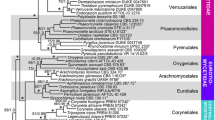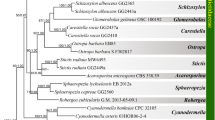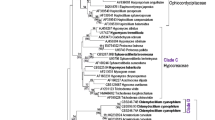Abstract
The rare apothecial, cupulate fungus Geopora pellita (Pyronemataceae) is characterized by a uniquely bright yellow-orange excipulum. We here re-examine its affiliations by use of morphological, molecular phylogenetic and ultrastructural analyses. G. pellita appears as phylogenetically rather isolated, being the sister group of a clade comprising Phaeangium, Picoa, the majority of the Tricharina species, and the remaining Geopora species. Based on its phylogenetic position and its unique combination of morphological characters, we assign G. pellita to Hoffmannoscypha, gen. nov., as H. pellita, comb. nov. As in a previous study, analyses of both large subunit (LSU) and internal transcribed spacer (ITS) ribosomal DNA suggest that the remaining genus Geopora is paraphyletic, with the hypogeous, ptychothecial type species more closely related to Picoa and Phaeangium than to the greyish-brownish cupulate and apothecial Geopora spp., indicating that the latter should be reassigned to the genus Sepultaria. The current study also shows that ITS confirm LSU data regarding the polyphyly of Tricharina.




Similar content being viewed by others
References
Agerer R, Ammirati J, Blanz P, Courtecuisse R, Desjardin DE, Gams W, Hallenberg N, Halling R, Hawksworth DL, Horak E, Korf RP, Mueller GM, Oberwinkler F, Rambold G, Summerbell RC, Triebel D, Watling R (2000) Open letter to the scientific community of mycologists: “always deposit vouchers”. Mycorrhiza 10:95–97
Benkert D (1994) Contributions to the knowledge of bryophilous Pezizales. 1. Lamprospora lubicensis, new species from Northern Germany. Z Mykol 60:195–202
Breitenbach J, Kränzlin F (1981) Pilze der Schweiz, Band 1. Ascomyceten. Mykologia, Luzern
Burdsall H (1968) A revision of the genus Hydnocystis (Tuberales) and of the hypogeous species of Geopora (Pezizales). Mycologia 60:496–525
Castellano MA, Trappe JM, Maser Z, Maser C (1989) Keys to spores of the genera of hypogeous fungi of North temperate forests with special reference to animal mycophagy. Mad River Press, California
Cooke MC, Peck CH (1872) Pezizae americanae. Grevillea 1:5–7
Dennis RWG (1981) British ascomycetes. J. Cramer, Vaduz
Dougoud R (2007) Définition taxonomique et clé du genre Geopora Harkness. Ascofrance website http://www.ascofrance.com/index.php
Ellis BM, Ellis JP (1998) Microfungi on miscellaneous substrates: An identification handbook. The Richmond Publishing and Co. Ltd., England
Erickson DL, Smith BD, Clarke AC, Sandweiss DH, Tuross N (2005) An Asian origin for a 10.000-year-old domesticated plant in the Americas. PNAS 51:18315–18320
Farris J (1972) Estimating phylogenetic trees from distance matrices. Am Nat 106:645–667
Farris JS (1974) Formal definitions of paraphyly and polyphyly. Syst Zool 23:548–554
Farris JS (1979) The information content of the phylogenetic system. Syst Zool 28:483–519
Felsenstein J (1981) Evolutionary trees from DNA sequences: a maximum likelihood approach. J Mol Evol 17:368–376
Fitch WM (1971) Towards defining the course of evolution: minimal change for a specified tree topology. Syst Zool 20:406–416
Gardes M, Bruns TD (1993) ITS primers with enhanced specificity for basidiomycetes application to the identification of mycorrhizae and rusts. Mol Ecol 2:113–118
Guevara-Guerrero G, Stielow B, Tamm H, Cázares-Gonzales E, Göker M (2011) Genea mexicana and Geopora tolucana, new sequestrate Pyronemataceae from Mexico, and the phylogeny of Geopora s.l. reevaluated. Mycol Prog 11:711–724
Hansen L, Knudsen H (2000) Nordic Macromycetes Vol. 1 Ascomycetes. Nordsvamp, Copenhagen
Hansen K, Pfister DH (2006) Systematics of the Pezizomycetes the operculate discomycetes. Mycologia 98:1029–1040
Hansen K, Laessoe T, Pfister DH (2001) Phylogenetics of the Pezizaceae, with an emphasis on Peziza. Mycologia 93:958–990
Hennig W (1965) Phylogenetic systematics. Ann Rev Entomol 10:97–116
Hess PN, De Moraes Russo CA (2007) An empirical test of the midpoint rooting method. Biol J Linn Soc 92:669–674
Kirk PM, Cannon PF, Minter DW, Stalpers JA (2008) Dictionary of the Fungi. CABI, UK
Krug JC, Khan RS (1991) Dictyocoprotus, a new genus of the Pyronemataceae with reticulated ascospores. Mycologia 83:103106
Læsso T, Hansen K (2007) Truffle trouble: what happened to the Tuberales? Mycol Res 111:1075–1099
Lee C, Grasso C, Sharlow MF (2002) Multiple sequence alignment using partial order graphs. Bioinformatics 18:452–464
Pattengale ND, Alipour M, Bininda-Emonds ORP, Moret BME, Stamatakis A (2009) How many bootstrap replicates are necessary? Lect Notes Comput Sci 5541:184–200
Pegler DN, Spooner BM, Young TWK (1993) British truffles, a revision of British hypogeous fungi. Royal Botanic Gardens, Kew
Perry BA, Hansen K, Pfister DH (2007) A phylogenetic overview of the family Pyronemataceae (Ascomycota, Pezizales). Mycol Res 111:549–571
Rice P, Longden I, Bleasby A (2000) EMBOSS: the European Molecular Biology Open Software Suite. Trends Genet 16:276–277
Sbissi I, Neffati M, Boudabous A, Murat C, Gtari M (2010) Phylogenetic affiliation of the desert truffles Picoa juniperi and Picoa lefebvrei. Anton Leeuw Int J G 98:429–436
Schumacher T (1979) Notes on taxonomy, ecology, and distribution of operculate discomycetes (Pezizales) from river banks in Norway. Nor J Bot 26:53–83
Spooner BM, Butterfill GB (1999) Coprophilous discomycetes from the azores. Kew Bull 54:541–560
Stamatakis A, Hoover P, Rougemont J (2008) A rapid bootstrap algorithm for the RAxML web servers. Syst Biol 75:758–771
Stielow B, Bubner B, Hensel G, Münzenberger B, Hoffmann P, Klenk H-P, Göker M (2010) The neglected hypogeous fungus Hydnotrya bailii Soehner (1959) is a widespread sister taxon of Hydnotrya tulasnei (Berk.) Berk. and Broome (1846). Mycol Prog 9:195–203
Stielow B, Bratek Z, Orczán KA, Rudnoy S, Hensel G, Hoffmann P, Klenk H-P, Göker M (2011) Species delimitation in taxonomically difficult fungi: the case of Hymenogaster. PLoS One 6:e15614
Swofford DL (2002) PAUP*: Phylogenetic analysis using parsimony (*and other methods), Version 4.0 b10. Sinauer Associates, Sunderland
Tamm H, Poldmaa K, Kullman B (2010) Phylogenetic relationships in genus Geopora (Pyronemataceae, Pezizales). Mycol Prog 9:509–522
Vralstad T, Myhre E, Schumacher T (2002) Molecular diversity and phylogenetic affinities of symbiotic root associated Ascomycetes of the Heliotiales in burnt and metal polluted habitats. New Phytol 155:131–148
Weber NS, Trappe JM, Denison WC (1997) Studies on western American Pezizales. Collecting and describing Ascomata —macroscopic features. Mycotaxon 61:153–176
Wei J, Persoh D, Agerer R (2010) Four ectomycorrhizae of Pyronemataceae (Pezizomycetes) on chinese pine (Pinus tabulaeformis): a morphoanatomical and molecular phylogenetic analyses. Mycol Prog 9:267–280
Wells VL, Kempton PE (1967) Studies on the fleshy fungi of Alaska. J Nat Prod 30:258–268
White TJ, Bruns TD, Lee S, Taylor J (1990) Amplification and direct sequencing of fungal ribosomal RNA genes for phylogenetics. In: Innis MA, Gelfand DH, Sninsky JJ, White TJ (eds) PCR Protocols: A guide to methods and applications. Academic, New York, pp 315–322
Wiley EO, Lieberman BS (2011) Phylogenetics. Theory and practice of phylogenetic systematics, 2nd edn. Wiley-Blackwell, Hoboken
Yang CS, Korf RP (1985) A monograph of the genus Tricharina and of a new, segregate genus, Wilcoxina (Pezizales). Mycotaxon 24:467–531
Yao YJ, Spooner BM (1996) Notes on british species of Geopora. Mycol Res 100:72–74
Acknowledgments
We kindly thank Dr. Ellen Bloch, New York Botanical Garden Herbarium, for the straightforward loans of Sepultaria pellita (G. pellita) and Tricharina spp. specimens, as well giving permission for nucleic acid extraction from specimens and digitalization of the drawings by G. Massee and F. Seaver (included in the supplementary material). Dr. Dagmar Triebel, Botanische Staatssammlung München, is acknowledged for giving permission for nucleic acid extraction from Tricharina spp. specimens and the kind cooperation.
Author information
Authors and Affiliations
Corresponding author
Electronic supplementary material
Below is the link to the electronic supplementary material.
ESM 1
(PDF 38137 kb)
Rights and permissions
About this article
Cite this article
Stielow, B., Hensel, G., Strobelt, D. et al. Hoffmannoscypha, a novel genus of brightly coloured, cupulate Pyronemataceae closely related to Tricharina and Geopora . Mycol Progress 12, 675–686 (2013). https://doi.org/10.1007/s11557-012-0875-1
Received:
Revised:
Accepted:
Published:
Issue Date:
DOI: https://doi.org/10.1007/s11557-012-0875-1




